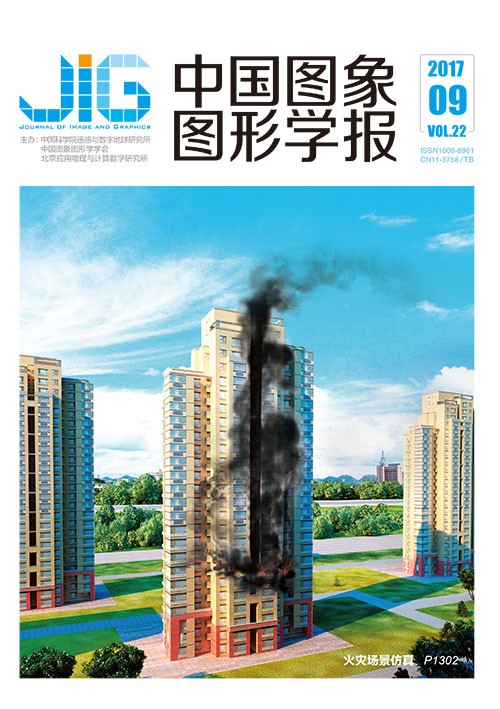
自适应多尺度分块压缩感知算法
摘 要
目的 基于小波域的多尺度分块压缩感知重构算法忽略了高频信号在重构过程中的作用,丢失了大量的边缘与细节信息。针对上述问题,提出一种自适应多尺度分块压缩感知算法,不仅合理利用低频信息还充分利用图像的高频信息,在图像细节复杂度提高的情况下保证图像重构质量的提高。方法 首先进行3层小波变换,得到一个低频信号和9个高频信号,分别进行小波逆变换后分成大小相同互不重叠的块,对低频部分采用2维邻块边缘自适应加权滤波的方法进行处理,对高频部分采用纹理自适应分块采样,最后利用平滑投影Landweber(SPL)算法对其进行重构。结果 与已有的分块压缩感知算法、基于边缘和方向的分块压缩感知算法和基于纹理和方向的分块压缩感知算法相比,本文算法在不同的采样率下,性能均有所提升,代表细节信息的高频信号得到充分重建,改进的算法所得到的重建图像具有较高的分辨率,尤其对细节较为丰富的图像进行重建后具有较高的峰值信噪比;2维邻块边缘自适应加权滤波有效的去除了重建图像的块效应,且重建时间平均减少了0.3 s。结论 将三层小波变换后的高频分量作为纹理部分,利用自适应多尺度分块重建出图像的轮廓与边缘;将低频分量直接视为平坦部分,邻块边缘自适应加权滤波重建出图像细节,不仅充分利用了图像的高低频信息,还减少了平坦块检测过程,使得重建时间有效缩短。经实验验证,本文算法重建图像质量较好,尤其是对复杂图像明显消除了块效应,边缘和纹理细节较清晰。因此主要适用于纹理细节较复杂的人脸图像、建筑图像和遥感图像等。
关键词
Adaptive multi-scale block compressed sensing algorithm
Cheng Deqiang, Gao Lingzhi, Chen Liangliang, Chen Gang, Tu Yilei(China University of Mining and Technology School of Information and Control Engineering, Xuzhou 221116, China) Abstract
Objective The concept of compressed sensing has become a crucial topic in the information research field since its introduction.In theory of compressed sensing,the sampling and compression of information are conducted simultaneously,thereby reducing storage space and computation amount.The sampling rate exceeds the limitation of the sampling rate of Shannon's theorem,which is greater than or equal to twice the bandwidth.Consequently,the sampling rate is reduced.Therefore,we can reconstruct the signal rapidly through minimal sampling.The block compressed sensing reconstruction algorithm uses the same sampling rate for each image block,which results in an unreasonable allocation of resources,and the reconstruction process will produce the block effect.The multi-scale block compressed sensing reconstruction algorithm also exhibits the following problems:1) The algorithm reduces block size to decrease storage space,which increases computation amount.2) A rough block edge remains when reconstructing a complex image.The edge and direction-based block compression sensing algorithm allocates the total sampling rate to the layers of sub-band by utilizing the characteristics of edge and direction.The adaptive multi-scale block compressed sensing algorithm allocates the sampling rate to each block image by using the texture and directionality of an image.These two algorithms reduce the number of samples to a certain extent,which considerably saves resources and improves reconstruction performance.Among the two,adaptive sampling is more effective for images with a large gap between smooth and complicated regions.The two algorithms reconstruct the low-frequency coefficients after wavelet transformation;thus,the details of the reconstruction effect on a complex image are non-ideal.An improved adaptive multi-scale block compressed sensing algorithm is proposed in this study to solve the aforementioned problems.This improved algorithm is expected to reasonably use the low-and high-frequency information of an image and enhance the quality of image reconstruction when the concerned image has high detail complexity.Method In the algorithm,three-layer wavelet transform is conducted to obtain a low-frequency signal and nine ways of a high-frequency signal,which are then inverted with wavelet transform and divided into non-overlapping blocks with the same size.After wavelet transform,a significant amount of energy of the original image focuses on the low-frequency signal,which leads to strong resistance and good stability.The low-frequency signal is processed using a 2D adjacent block edge adaptive weighted filter method.The same jump of the edge pixel gray scale among adjacent blocks produces the block effect.Thus,the four adjacent block edge characteristics around the pixel should be used for filtering.The edge pixel value of the adjacent block is weighted based on distance to obtain the updated pixel value.The wavelet transform of an image can be expressed as the superposition of the approximation signal of the low-resolution image and all the details of the signal.These details are obtained by decomposing each stage that belongs to the high-frequency signal.An adaptive texture block-sampling method is adopted for the high-frequency signal,and the smooth projected Landweber algorithm is used to reconstruct the image.The flat image is overlapped after weighted filtering,and higher-resolution reconstructed images can be obtained.Result Compared with existing algorithms,such as the block compression sensing algorithm,the edge and direction-based block compression sensing algorithm,and the texture-based block compression algorithm,the proposed algorithm exhibits improved performance under different sampling rates.The high-frequency signal that represents image details is fully reconstructed.The reconstructed images obtained from the improved algorithm have higher resolution,particularly the images with considerable details.The reconstructed images also obtain a high peak signal-to-noise-ratio.The 2D adjacent block edge adaptive weighted filter is an effective method for removing the block effect on the reconstructed image,and reconstruction time is reduced by 0.3 s.Conclusion After conducting three-layer wavelet transform,the high-frequency signal is used as part of the texture,and an adaptive multi-scale block compressed sensing algorithm is adopted to reconstruct the contours and edges of the image.The low-frequency signal is regarded as the flat part,and the neighbor block-relied filtering method is used to reconstruct image details.Reconstruction time is effectively shortened by reasonably utilizing the low-and high-frequency information of an image and reducing the process to detect the flat block.After the experiment,the quality of the reconstructed images is evidently improved,particularly the images with significant details.The block effect on the images is also apparently eliminated,and the reconstructed images have clear edges and texture details.Thus,an adaptive multi-scale block compressed sensing algorithm is mainly applied to images with complex texture,such as face,architectural,and remote sensing images.
Keywords
wavelet transform adaptive multi-scale block compressed sensing texture neighbor block-relied filtering smoothed projected Landweber
|



 中国图象图形学报 │ 京ICP备05080539号-4 │ 本系统由
中国图象图形学报 │ 京ICP备05080539号-4 │ 本系统由